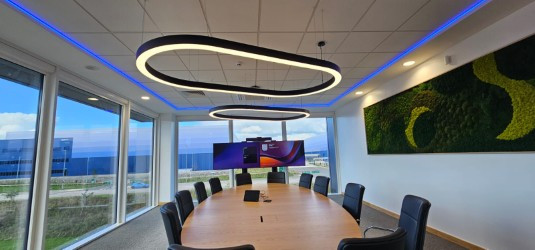Microgrids - powering people worldwide
There is a growing trend where energy is not just delivered, it's generated and shared within communities, building resilience and independence. This is not a utopian dream - it's called the power of microgrids - and it's transforming the way we think about energy writes John Ridgeway.
Forget about dependence on large, centralised grids vulnerable to power cuts and price fluctuations. Microgrids empower communities to become ‘prosumers’, generating their own energy through solar panels, wind turbines, and other renewable sources. This locally produced power is then distributed intelligently through smart grids, ensuring everyone has access to clean, reliable energy even when the main grid falters.
For remote communities and developing regions, microgrids offer a lifeline. Lack of access to traditional electricity grids often leaves them in the dark, hindering growth and development. Microgrids bridge this gap, providing a sustainable and affordable solution for lighting homes, powering schools and clinics, and boosting local economies.
But the impact of microgrids extends far beyond remote areas. In urban environments, they can increase energy security, particularly when coupled with energy storage solutions like batteries. In such situations microgrids can provide backup power during cuts, keeping critical infrastructure and businesses operational.
Such initiatives are helping to reduce reliance on fossil fuels. By harnessing renewable energy sources, microgrids are actively contributing to decarbonisation efforts and are helping to combat climate change.
This is energy democracy in action. Microgrids are democratising access to energy, empowering communities to take control of their power needs and to directly participate in energy markets.
Rural Alaska presents a unique case study for how microgrids can revolutionise lives. Isolated from the main grid, many communities have historically relied on expensive and environmentally damaging diesel generators for their limited electricity needs. But the tide is turning, thanks to microgrids powered by the abundant natural resources of hydropower and wind.
Alaska boasts numerous rivers and streams, perfect for harnessing the power of hydropower. Microgrids equipped with small hydro turbines can generate clean, reliable electricity, significantly reducing dependence on diesel. The country’s vast, windswept landscapes also offer another potent source of renewable energy. Microgrids with wind turbines can capture the power of the wind, transforming it into electricity.
The impact of these microgrids extends far beyond just illuminating houses. Communities are no longer beholden to volatile diesel prices and vulnerable supply chains. They take control of their energy needs, boosting resilience and promoting self-sufficiency.
Replacing diesel with renewable sources slashes carbon emissions, combating climate change and protecting Alaska's pristine natural environment. Microgrid development also creates local jobs in installation, maintenance, and related industries, injecting vitality into the local economy.
With this kind of development comes Improved quality of life. Reliable access to electricity means better healthcare, education, and communication facilities.
While the future looks bright, some challenges remain. Installing microgrids can be expensive, requiring innovative financing models and collaboration between communities, governments, and private investors. Alaska's extreme weather also demands robust and adaptable technologies to ensure consistent energy production. There further has to be seamless integration with existing grids, crucial to ensure optimal efficiency and stability.
However, solutions are actively being pursued. Technological advancements are making microgrids more affordable and efficient, while collaboration and policy innovations are addressing financing and integration challenges – and we are seeing some successes.
Kwethluk is a tiny village which now boasts a hydro-powered microgrid, replacing its diesel dependence and achieving significant cost savings. Kaktovik, another small village utilises a wind-powered microgrid, empowering residents and reducing fossil fuel consumption.
The Alaskan microgrid story is a beacon of hope, showing how remote communities can embrace renewable energy to achieve energy independence, environmental sustainability, and improved quality of life. As technologies advance and support structures evolve, we can expect more and more Alaskan villages to light up their futures with the power of nature, paving the way for a brighter future for all.
This is a story that is steadily developing worldwide. Falling costs of renewable energy, means that solar panels and wind turbines are becoming increasingly affordable, making them a viable option for microgrid installations.
Advanced software and communication systems are being developed to enable efficient management and distribution of energy within microgrids. This means that governments are increasingly recognising the potential of microgrids and implementing policies to incentivise their development.
Microgrids are not just a theoretical concept - they are already powering other communities around the world. Brooklyn Microgrid in New York City is a microgrid powered by solar panels and energy storage batteries. It is providing backup power to critical infrastructure in a vulnerable low-income community.
The Brooklyn Microgrid isn't just about keeping the lights on - it's about building resilience and empowering a community often overlooked. Here's what makes it so remarkable:
By providing backup power during outages, the microgrid safeguards healthcare access, food security, and communication within the community, lessening the impact of disruptions and protecting critical services.
Replacing fossil fuel-based backup generators with clean solar energy is promoting sustainability and combating climate change, improving air quality for residents and contributing to a greener NYC.
Most important of all, this project is actively engaging residents, offering educational workshops and training programmes on renewable energy and energy efficiency. This fosters a sense of ownership and empowers the community to participate in their energy future.
The Brooklyn Microgrid isn't just a technological marvel - it's a pioneer in several ways. Residents with solar panels can generate and sell excess energy to their neighbours, creating a local energy marketplace and fostering community interdependence. The microgrid utilises blockchain technology to securely track and manage energy transactions, ensuring transparency and fairness in the peer-to-peer energy market.
The success of the Brooklyn Microgrid paves the way for similar projects in other vulnerable communities, bringing resilience and environmental benefits to marginalised neighbourhoods across the city.
But in spite of its successes, the Brooklyn Microgrid has faced some challenges. Installation can be expensive, requiring innovative financing models and continued fundraising efforts to ensure long-term sustainability. Adapting existing regulations to accommodate peer-to-peer energy trading and microgrid integration has also demanded ongoing collaboration with policymakers and utilities.
The Brooklyn Microgrid is a shining example, but as we have shown, similar projects are sprouting across the globe, from remote villages to bustling cities. From microgrids powered by tidal waves in Maine to solar-powered communities in Kenya, the message is clear - empowering communities with renewable energy is the future.
Sources:
- International Renewable Energy Agency (IRENA): https://www.irena.org/
- Microgrid Resource Center: https://www.nrel.gov/news/features/2022/microgrids-for-anyone.html
- Clean Energy Group: https://www.cleanegroup.org/
- World Future Council: https://www.worldfuturecouncil.org/
Additional Blogs

The changing face of workplace AV and what FM managers need to know
In today’s hybrid workplaces, facilities managers can no longer treat audio-visual systems as background infrastructure - they are now mission-critical assets that directly influence productivity,...
Read moreConstruction’s obsession with blame instead of learning
Construction is one of the most technically advanced industries in the built environment, yet culturally it often behaves like one of the least reflective. When things go wrong and they frequently...
Read more

How risk Is routinely pushed down the supply chain
Risk is an unavoidable part of construction. Every project involves uncertainty around ground conditions, weather, design coordination, procurement, labour and programme. Yet while risk is inherent,...
Read more